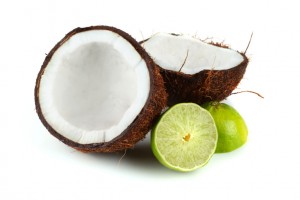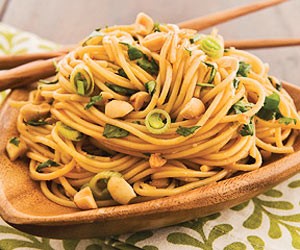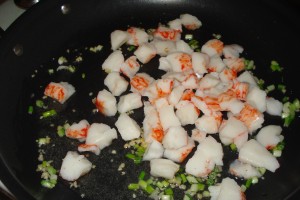This recipe is amazingly delicious and versatile. It works as a sauce for noodles (hot or cold), a marinade for meat or fish, a slow-cooker sauce or as a base for vegetables and meat in a thai-style curry over rice.
SARAH’S THAI-STYLE PEANUT SAUCE
1/2 cup creamy peanut butter
1 (14oz) can coconut milk
2 tablespoons lime juice
2 tablespoons soy sauce
1 tablespoon brown sugar
2 teaspoons ground ginger
1 teaspoon minced garlic
dash of cayenne pepper (or to taste)
 Combine the above ingredients in a bowl or saucepan or crock pot. I like to use an immersion blender to integrate the peanut butter and puree the garlic. Use cold as a sauce for noodles, for dipping or as a marinade. Add meat and/or vegetables to the sauce for slow cooking or heat in a pan for curry or noodles. Garnish with fresh cilantro.
Combine the above ingredients in a bowl or saucepan or crock pot. I like to use an immersion blender to integrate the peanut butter and puree the garlic. Use cold as a sauce for noodles, for dipping or as a marinade. Add meat and/or vegetables to the sauce for slow cooking or heat in a pan for curry or noodles. Garnish with fresh cilantro.
I’ve used this sauce many times before with meat (usually chicken) and vegetables as a curry over rice. This past weekend, I decided to combine it with some faux crab meat (chunk style), put it over noodles and garnish with some green onions.
I ran into a bit of a roadblock with the noodles, however. Having been to two different Thai restaurants in the last few weeks, I noticed that the menus included noodle dishes containing Thai egg noodles. However, when I was out and about at grocery stores this week, I could only find Thai rice noodles. The Thai egg noodles I’ve had in the past — and thus the ones I had in mind — have been relatively wide and flat, not unlike fettuccine. Browsing other types of Asian noodles at these grocery stores, I found nothing to replicate that memory of Thai egg noodles. I couldn’t even find any on Amazon.
I realized, of course, that I could very well make my own noodles. Flour, eggs and a pasta maker were already in my kitchen. I’m always reluctant to make my own noodles, however, because of the cleanup. Making dough, be it water- or egg-based, is always easy in the food processor, but the extra flour required to ease the dough’s path through the pasta maker gets EVERYWHERE. It’s one thing to clean up my workspace, but to have to clean the floors and every stray little item nearby with a light dusting from clouds of flour doesn’t seem worth the effort.
 After hitting my last dead-end with the search for something that could pass as a Thai egg noodle, I promised myself that if I felt ambitious enough the next day, I would make my own noodles, but if not, I would simply use the angel-hair-like Chinese egg noodles already in my cupboard.
After hitting my last dead-end with the search for something that could pass as a Thai egg noodle, I promised myself that if I felt ambitious enough the next day, I would make my own noodles, but if not, I would simply use the angel-hair-like Chinese egg noodles already in my cupboard.
I was up early the next day without much else to do, so I decided to attempt the noodles. The idea struck me that if I could make the dough just dry enough, I might not need to add extra flour and make a mess. I started with a cup of flour, added a couple eggs, added a bit more flour, etc. until I got a food processor full of fine, powdery dough that formed a somewhat tacky ball when I grabbed a handful and worked it with my hands.
Here is the recipe/method I came up with:
SARAH’S EASY EGG NOODLE DOUGH
2 cups flour (plus at least 1/4 cup in reserve)
3 eggs
Combine the flour and eggs in the food processor. If your eggs are large, you may want to start with two, and reserve the third. The result should be a mealy or powdery substance that will form a ball of dry-ish dough when kneaded in batches. If the dough does not hold together when you try to form a ball, or if it stays somewhat together but cracks, then it is too dry. If the dough won’t even hold together, add your third egg; if it holds together but is too dry to knead without it cracking, try adding a tablespoon of water. If it is too sticky to go through the pasta maker (the pasta maker rollers should be dry without any sticky dough residual after the dough goes through), return the dough to the food processor and add a tablespoon or two of flour. Depending on how large your eggs are, you may need to add more or less flour. Just keep adding it a tablespoon at a time until you get your desired result.
I was able to make a dough with about 2 cups, plus one tablespoon flour, and 3 medium eggs that needed no additional flour for the pasta maker. The process created a few dough crumbles, but they were much easier to clean from my workspace, counter and floor, than a ubiquitous dusting of flour.







